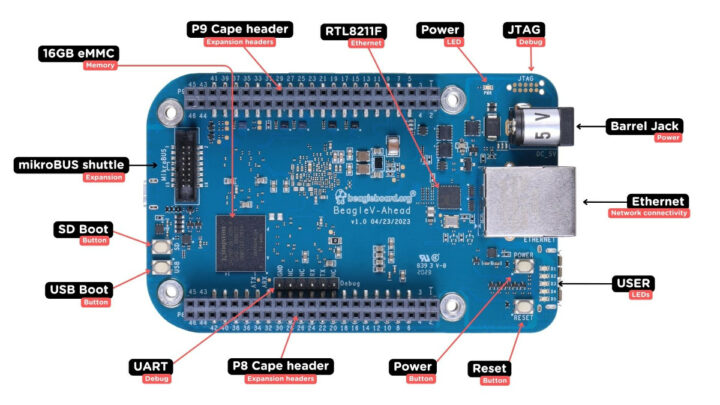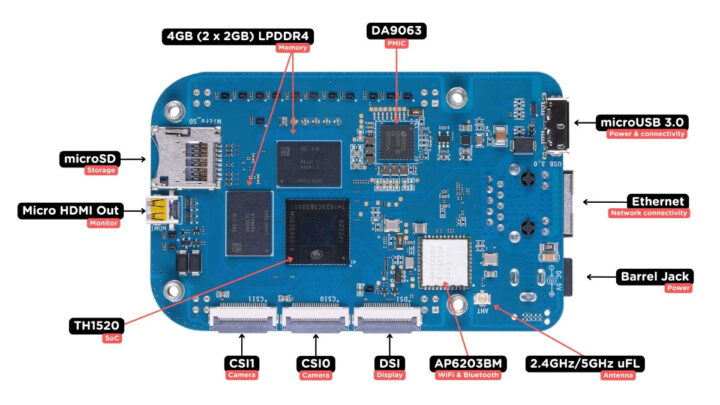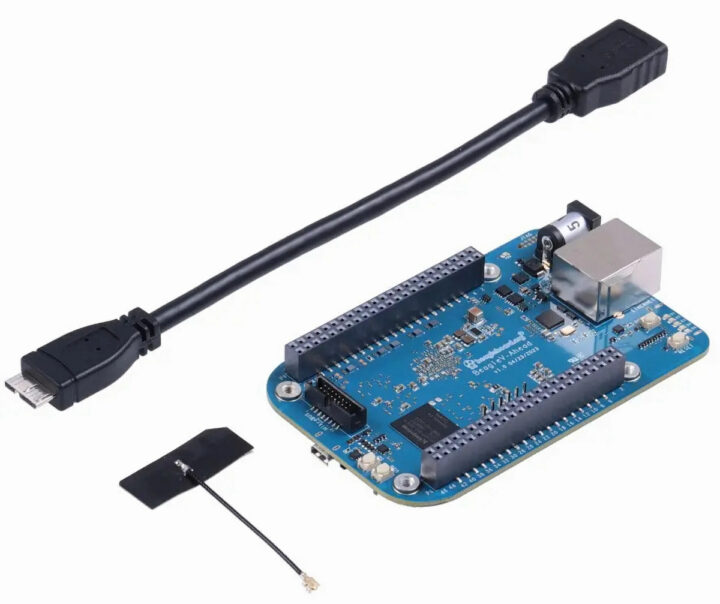Beagleboard.org Foundation’s BeagleV-Ahead is a single board computer powered by the T-Head TH1520 quad-core RISC-V processor and following the form factor of the popular BeagleBone Black board based on a Texas Instruments Sitara AM3359 single-core Arm Cortex-A8 processor.
The new board looks better in almost every way with a much faster processor, 4GB RAM, 16GB eMMC flash, Gigabit Ethernet, built-in WiFI and Bluetooth, a micro USB 3.0 port, micro HDMI video output up to 4Kp60, etc… and the same 80-pin headers as found on other BeagleBone boards. The main downside is that it comes at a significantly higher price as we’ll see further below.
BeagleV-Ahead specifications:
- SoC – Alibaba T-Head TH1520
- CPU – quad-core RISC-V Xuantie C910 (RV64GCV) processor @ up to 2.0 GHz, low power Xuantie E902 core
- GPU – Imagination BXM-4-64 GPU with OpenGL ES 3.2, OpenCL 2.0, Vulkan 1.2, 50.7GFLOPS
- DSP – Xuantie C906 audio DSP @ 800 MHz,
- AI accelerator – 4 TOPS NPU
- VPU – H.265/H.264 @ 4Kp75 video decoder, H.265/H.264 @ 4Kp40 video encoder
- System Memory – 4GB LPDDR4
- Storage – 16GB eMMC flash + microSD slot
- Video Output – micro HDMI port up to 4Kp60, MIPI DSI connector
- Audio – Digital audio output via HDMI
- Camera – 2x MIPI CSI connectors
- Networking
- Gigabit Ethernet RJ45 port via RTL8211F transceiver
- 2.4GHz/5GHz WiFi 4 up to 72 Mbps and Bluetooth 5.0 via Ampak AP6203BM and u.FL antenna connector
- USB – 1x micro USB 3.0 port
- Expansion
- P8 and P9 80-pin Cape headers for expansion boards (3.3V only)
- mikroBus shuttle connector for MikroElektronika click boards
- Debugging – 6-pin serial header
- Misc
- Indicators – Power, Ethernet, and 4x user’s LEDs
- Buttons – USB boot, SD Boot, Reset, and Power
- Power Supply
- 5V DC via power barrel jack
- DA9063 PMIC
- Dimensions – ~86.4 x 53.4 mm

 Ubuntu 23.04 and Yocto Linux images are provided for the board along with source code, and work-in-progress documentation can be found on beagleboard.org. Like other boards from the foundation, the BeagleV-Ahead is open-source with hardware design files available for download. You can also get support in the forums.
Ubuntu 23.04 and Yocto Linux images are provided for the board along with source code, and work-in-progress documentation can be found on beagleboard.org. Like other boards from the foundation, the BeagleV-Ahead is open-source with hardware design files available for download. You can also get support in the forums.
That’s another great development for the RISC-V ecosystem as a whole, and for the T-Head T1520 processor which is already used in the LicheePi 4A SBC and has plenty of commits in the upcoming Linux 6.5 release. That also means we now have a BeagleBone board with performance roughly equivalent to the Raspberry Pi 4 while keeping the many I/Os from the BeagleBone form factor. It does lack PRU support from the Texas Instruments SoC, but only time will tell how much it matters to various projects designed for the BeagleBone Black and compatible.
The BeagleV-Ahead RISC-V SBC is sold for $149 and up on distributors such as OKDo and Digi-Key. That’s a somewhat similar price to the $135 asked for the LicheePi 4A 8GB/32GB, but obviously much higher than the $55 Raspberry Pi 4 4GB (provided you can find it at that price). You’ll find more distributors and a few more details on the product page.

Jean-Luc started CNX Software in 2010 as a part-time endeavor, before quitting his job as a software engineering manager, and starting to write daily news, and reviews full time later in 2011.
Support CNX Software! Donate via cryptocurrencies, become a Patron on Patreon, or purchase goods on Amazon or Aliexpress





